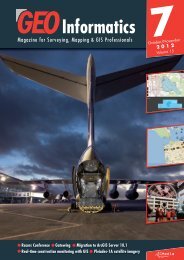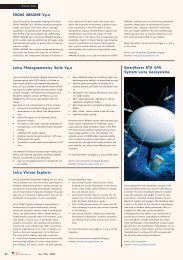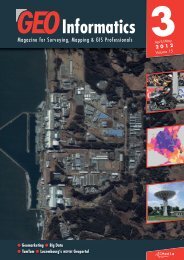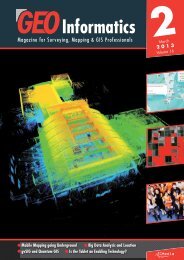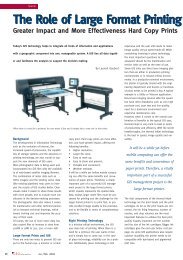2013 - Geoinformatics
2013 - Geoinformatics
2013 - Geoinformatics
Create successful ePaper yourself
Turn your PDF publications into a flip-book with our unique Google optimized e-Paper software.
38<br />
R e v i e w<br />
By Eric van Rees<br />
Esri Press recently published an updated version of the second part of its GIS<br />
Tutorial series, offering exercises and data for the latest version of its ArcGIS<br />
software.<br />
U p d a t e d E s r i G I S T u t o r i a l<br />
Spatial Analysis Workbook for ArcGIS 10.1<br />
Contents and target audience<br />
This book was published early <strong>2013</strong> and<br />
has been updated for ArcGIS 10.1, which<br />
is the latest version of this software. It offers<br />
nine tutorials or hands-on exercises for performing<br />
spatial analysis, and comes with a<br />
DVD that includes data and a 180-day trial<br />
of ArcGIS 10.1 for Desktop Advanced software.<br />
The book’s key objective is to assist<br />
the reader in developing their knowledge<br />
of the analysis tools of ArcGIS and teaching<br />
them how to design the right sequences to<br />
bring the big picture into view. The tutorials<br />
focus on data representation and equip<br />
readers with the skills to build ‘big picture’<br />
maps. As stated in the preface of this book,<br />
the user won’t create new data, but will create<br />
new files based on existing data.<br />
The contents can roughly be divided into<br />
two categories: tutorials 1-6 correspond<br />
with another Esri publication, called ‘The<br />
Esri Guide to GIS Analysis, Volume 1’, and<br />
tutorials 7-9 correspond with the second<br />
volume. It is recommended that the user of<br />
this book reads the corresponding chapters<br />
of these two volumes before each tutorial.<br />
Some of the tutorials require the ArcGIS<br />
10.1 Spatial Analyst for Desktop extension,<br />
which accompanies the book.<br />
Title: GIS Tutorial 2: Spatial Analysis Workbook for ArcGIS 10.1<br />
Author: David W. Allen<br />
Publisher: Esri Press<br />
Language: English<br />
Number of pages: 344<br />
ISBN: 9781589483378<br />
The book starts off with relatively easy instructions, but the tasks gradually<br />
become more complex and involve multiple steps in order to obtain<br />
the final results for analysis. The first four chapters are more about map<br />
visualization than complex spatial analysis, but from then on things get<br />
more interesting: creating buffers, performing distance analysis, measuring<br />
geographic distribution, and finally, analyzing patterns and identifying<br />
clusters through statistical analysis tools.<br />
In each tutorial, the reader has to fulfill a task that requires a number of<br />
steps for analysis. These are shown step-by-step, through helpful screenshots<br />
of the final results. In addition, there are tasks which support independent<br />
skill demonstration, as well as study questions and review sections<br />
after the exercises. At the end of the book there are a number of<br />
extra independent projects which combine the analysis functions described<br />
in the previous chapters.<br />
This publication is geared towards a more advanced readership than<br />
the first part of this series (‘GIS Tutorial 1:<br />
Basic Workbook) and requires use of<br />
ArcGIS and ArcGIS extensions, knowledge<br />
of ArcMap and ArcCatalog, as well as thirdparty<br />
tools and scripts.<br />
Verdict<br />
For a hands-on do-it-yourself course in performing<br />
GIS analysis with ArcGIS 10.1, or<br />
as material for a face-to-face course in a classroom,<br />
this book is an excellent choice. It<br />
has everything you could possibly need: you<br />
get the data, the software and helpful tutorials<br />
all in one package. The book is wellwritten,<br />
the layout is very good, the imagery<br />
is helpful in working your way through<br />
the exercises and the review sections are<br />
useful. You don’t get the answers to the extra<br />
tasks, but this isn’t a major issue.<br />
Although the book has information on the<br />
theoretical background of the analysis functions<br />
which are covered, this is not the key<br />
objective of the book. This becomes a problem<br />
in the last few chapters, which cover<br />
complex mathematical methods used in statistics,<br />
for instance when it comes to interpreting<br />
results after applying a certain function.<br />
The Help function of ArcGIS provides a lot<br />
of information on spatial analysis, as does<br />
the online Esri Resource Center, so there’s no need to pay for an additional<br />
publication offering this information.<br />
Since the book does cover a lot of ground, it can be a good thing to<br />
read through the whole tutorial again after finishing it to get ‘the big picture’<br />
and distinguish between multiple analysis functions which may seem<br />
very similar, but should be used under specific circumstances and for<br />
specific purposes only. This is important, because if you’re not aware of<br />
what you’re doing, you might end up drawing the wrong conclusions<br />
from your dataset. What is a plus about this book is that the data provided<br />
on the DVD is ready for use, which is good for a learning environment.<br />
It’s important to remember, however, that the real world situation<br />
might be a bit more complex than shown in the book.<br />
For more information, have a look at: esripress.esri.com.<br />
June <strong>2013</strong>





